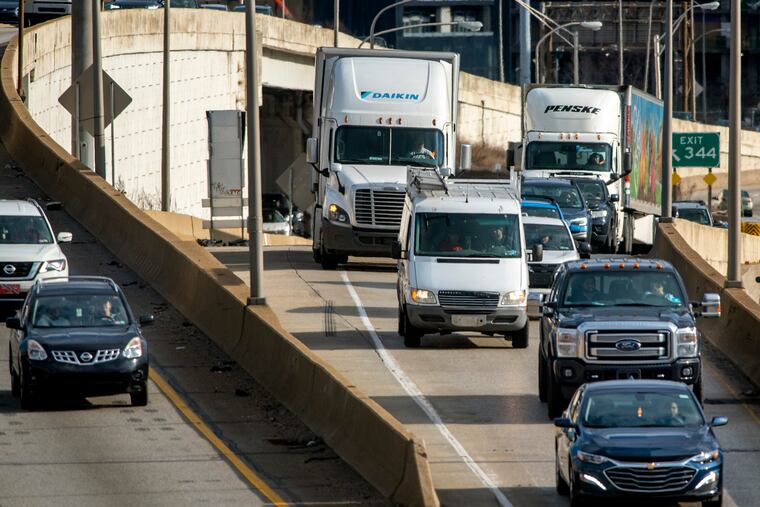Philly’s traffic jams cost truckers time — and consumers money
The pandemic traffic plunge helped increase freight truck speeds, but deliveries still slow to a crawl in the nation’s worst choke points.

Everyone hates the colossal time suck of the Philadelphia interchange where the Schuylkill and Vine Expressways meet. Just try threading that needle behind the wheel of a fully loaded 80,000-pound tractor-trailer.
Big rigs reached an average gear-grinding speed of 30.7 mph there during peak traffic hours last year, according to analysis by the American Transportation Research Institute.
Believe it or not, that was 32% faster than in 2019. But during the afternoon rush, from 3 to 7 p.m., trucks crept through the interchange at about 20 mph, the analysis found.
ATRI combs yearly through GPS data from more than one million trucks at 300 specific locations in the nation’s interstate highway system to document the impact of traffic congestion on the movement of freight, and recently released its list of the 100 worst truck bottlenecks of 2020.
The junction of I-676 and I-76 ranked 26th. All told, the Philadelphia area has five of the top 100 truck choke points in the United States. Harrisburg has one, and Pittsburgh has two.
» READ MORE: Breezewood, Pa., famed interstate traffic choke point | A photo essay
Speeds ticked up at most of the nation’s freight bottlenecks last year because of the COVID-19 pandemic. Interstate traffic of all kinds plummeted amid restrictions on commerce, and states used the slowdown to finish some congestion-easing construction, said Rebecca M. Brewster, president of ATRI.
“Truck speeds were up, and congestion was reduced in 2020, and that is an anomaly,” she said. “Even though there was improvement, it wasn’t really anything to write home about.”
In the second half of 2020, the tonnage of freight carried by trucks climbed back to near pre-pandemic levels, driven in part by increased demand for Amazon and other internet-based retailers.
Interstate 76 lies at the center of most of the other trouble spots in the Philadelphia region. West of the interchange with the Vine Expressway, I-76 at U.S. 1 (No. 47) and I-76 at I-476, the Blue Route (No. 76), bedevil truckers. To the east, at the foot of the Walt Whitman Bridge in Camden, the cloverleaf at I-76 and I-676, called the North-South freeway there, clocks in at No. 70.
It’s not easy to quantify the costs of highway congestion to the trucking industry. But a detailed study estimated more than a billion hours of lost productivity in 2016 nationally as drivers sat in traffic, representing $74.5 billion in added operational costs.
At least some of the extra expense will be passed down the supply chain and to the consumer. There also are other costs, such as environmental damage, as idling trucks spew diesel particulate pollution from their exhausts.
Since the vast majority of U.S. domestic freight moves by truck, persistent delays caused by Philadelphia’s expressway choke points could damage the regional economy, said Rebecca Oyler, president of the Pennsylvania Motor Truck Association, an industry advocacy group in Camp Hill.
“Eventually it’s going to affect the economic competitiveness of the region,” Oyler said. “When trucks are regularly delayed, manufacturing companies and warehouse companies, for example, are going to shy away from locating there. They can’t afford undependable delivery service.”
She said there needs to be a “reassessment of roads,” how to design and pay for them. Pennsylvania has among the highest motor fuel tax rates in the country — at about 58 cents per gallon for gasoline and 74 cents for diesel. Still, there is more demand for maintenance and construction projects than the taxes can fund. Fuel taxes do not support transit in the state.
Already the state trucking association is battling PennDot’s plan to put tolls on nine bridges to pay for their upkeep, with the help of private investors. A major bridge across the Susquehanna River in Harrisburg and the Girard Point Bridge in Philadelphia are among them.
Oyler argued that efforts to evade new tools would create or worsen bottlenecks. “At least let’s not make it worse,” she said.
» READ MORE: Why is Philly stuck in traffic? Five fixes for congestion
The reasons Philadelphia has what seems like more than its share of bottlenecks: exponential growth and old roads with little room for expansion due to topography and development patterns.
“There’s a lot of old roadway geometry,” said Thomas K. Edinger, who runs congestion management programs for the Delaware Valley Regional Planning Commission. “Around the Northeast, our roadways were built in the ’50s, or even earlier, and they weren’t designed for the kind of traffic we have now.”
Rights-of-way in Philadelphia are constrained. Consider the Schuylkill Expressway, with cliffs on one side and the river on the other. Over the years, several political leaders have proposed building an upper deck on the road for autos and trains, with heavy trucks and buses running below. (Too expensive even if it’s feasible.)
In Georgia, truck-only lanes are used on parts of Interstate 75 between the port of Savannah and metro Atlanta, but there’s not enough room on the most traffic-choked Philadelphia highways.
Engineers and planners are considering much more modest approaches, such as using reinforced shoulders on the Schuylkill as flex travel lanes to relieve the worst congestion. That approach is being deployed at I-95 and I-476, with technology to change posted speed limits and put congestion warnings on electronic billboards so drivers can quickly adjust, Edinger said.
“To manage congestion, we have to rely on other ways of reducing traffic vs. building more capacity,” he said. Even if there were room, it’s well-known that expanding roads induces more traffic, and they are “as crowded as before.”